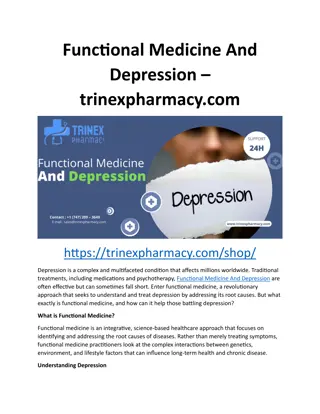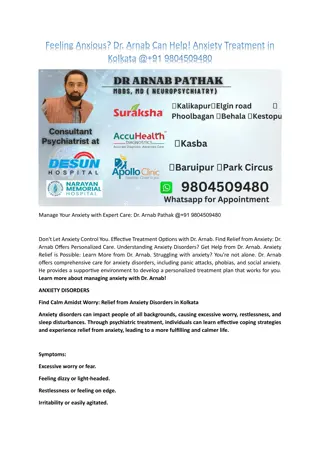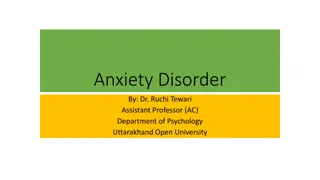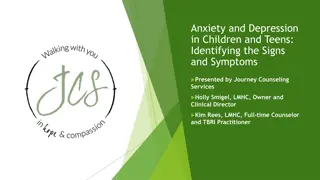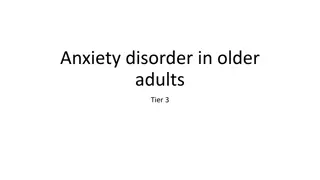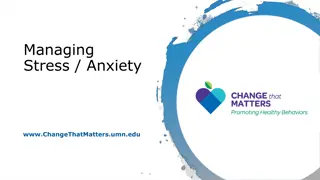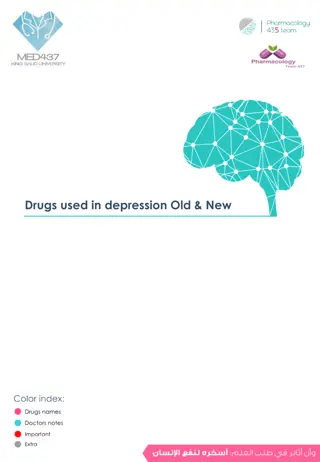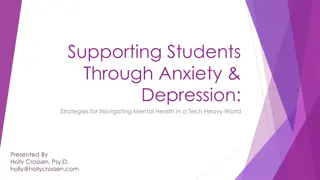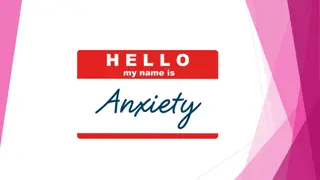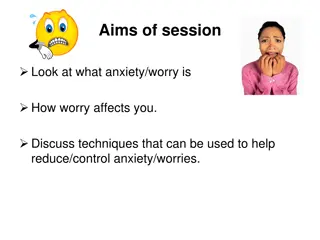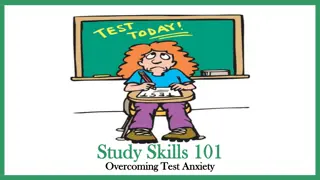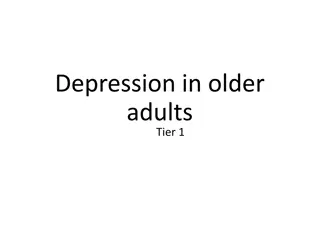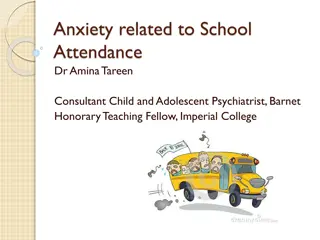Understanding Anxiety and Depression in School-Aged Children
This informative material by Licensed Clinical Psychologist, Laura Koehler, Psy.D., delves into the definition, symptoms, sources, and signs of anxiety, as well as the differentiation between school refusal and truancy. It also touches on the definition and management of depression, emphasizing strategies to handle difficult emotions and ways to seek help and support for children experiencing these challenges.
Uploaded on Sep 16, 2024 | 0 Views
Download Presentation

Please find below an Image/Link to download the presentation.
The content on the website is provided AS IS for your information and personal use only. It may not be sold, licensed, or shared on other websites without obtaining consent from the author. Download presentation by click this link. If you encounter any issues during the download, it is possible that the publisher has removed the file from their server.
E N D
Presentation Transcript
Anxiety and Depression in School- Aged Children Laura Koehler, Psy.D. Licensed Clinical Psychologist 2
Objectives Define anxiety Healthy anxiety versus anxiety disorders School refusal versus school truancy Define depression Sadness versus depression Strategies and skills to manage difficult emotions Exploring ways to get help and support 3
Definition of Anxiety A feeling of worry, nervousness or unease typically about an imminent event or something with an uncertain outcome. (Merriam-Webster s) Anxiety is a normal emotion and common experience. It is one of the most basic of human emotions. In general, anxiety serves to motivate and protect an individual from harm or unpleasant consequences.
Common Anxiety Symptoms Heart palpitations Chest tightness Numbness/tingling Fidgeting Short of breath/heavy breathing Dizziness Blurred/distorted vision Nausea Sweating Stomach aches Muscle tension Nail biting Lump in throat Tapping foot/fingernails Shaking Butterflies stomach Having a lump in your throat Headaches/migraines Difficulties concentrating
Sources of Anxiety New situations or transitions Worries about being judged or evaluated by others School anxiety Concern about the future, world events, germs or medical health Separation from loved ones Trauma Fear of having panic attacks Performance anxiety 6
Signs of Anxiety Intense physical sensations, like stomach aches or headaches Staying home or isolating in bedroom Leaving class, frequent trips to guidance office/nurse or asking to stay home from school Unwilling to engage in hobbies or extracurricular activities Struggles with concentration/focus/retrieving information Seeking re-assurance from support Repetitive behaviors Sleeping difficulties Lack of appetite or overeating Constant fidgeting 7
School Refusal versus School Truancy (Freemont, 2003) School Refusal (Anxiety) Severe emotional distress about attending school Parents are aware of absence, child tries to persuade parents to allow child to stay home Absence of antisocial behaviors School Truancy Lack of excessive anxiety or fear about attending school Absence is concealed from parents Frequent antisocial behavior, such as lying, breaking rules or stealing Child prefers to be away from home Child usually wants to stay home, as they consider it safe and secure Child expresses willingness to do schoolwork, however anxiety may present itself while completing it Lack of interest in schoolwork and unwillingness to conform to academic expectations 8
Sadness Versus Depression Sadness Basic human emotion Triggered by a difficult experience Feel sad about something Depression State or episode Triggers are not necessary Pervasive and chronic 9
Definition of Depression Affects how one thinks, feels and completes daily activities of life Mood Disorder Symptoms occur most of the day, nearly every day for at least a two week period Episode not an emotion 10
Common Depressive Symptoms Depressed mood / irritable mood Sad or empty feeling Loss of interest or pleasure Sleep disturbances Decrease or increase in appetite Fatigue or loss of energy Feelings of worthlessness or guilt Difficulties concentrating Suicidal thoughts Moving or talking more slowly Aches or pains 11
When Anxiety and Depression Become Problems Disrupts daily activities and quality of life Moves you away from your values: Friendships Family relationships Role-modeling Education Religion/spirituality Self-care Hobbies/interests Community life Romantic relationships Career
Dialectical Behavioral Therapy (DBT) Developed by Marsha M. Linehan, Ph.D. from the University of Washington, Seattle A multi-modal psychosocial treatment approach DBT was created to be an organized, systematic approach to create structure and to enhance decision making and problem solving General goal: to learn and refine skills in changing behavioral, emotional, and thinking patterns associated with problems in living, that is, those causing misery and distress
Mindfulness Mindfulness means paying attention, in a particular way, on purpose, in the present moment and non-judgmentally. - Jon Kabat-Zinn Goals of mindfulness: Reduce suffering and increase happiness Observe or notice thoughts Experience reality as it is Reduce past and/or future thinking Get engaged in the present moment Refocus mind when distracted
Mindfulness Exercises 4 square breathing Balloon breathing 5-4-3-2-1 Drop anchor 15
Breathing Exercises 4 Square breathing Breath in for 4 seconds Hold for 4 seconds Breath out for 4 seconds Hold for 4 seconds Repeat 4 times IN - 4 seconds HOLD - 4 seconds HOLD - 4 seconds 4X OUT - 4 seconds Balloon breathing Imagine you have a balloon in your belly Breath slowly and deeply Every time you breath in, imagine the balloon inflating Every time you breath out, imagine the balloon deflates Repeat 10 times 16
5-4-3-2-1 With Your Senses Find 5 things you can SEE. Find 4 things you can HEAR. Find 3 things that you can FEEL or TOUCH. Find 2 things you can SMELL. Find 1 thing you can TASTE. 17
Drop Anchor by Russ Harris Plant your feet into the floor and push them down Notice the floor beneath you, supporting you Increase your awareness of the muscle tension in your legs as you push your feet down Notice your entire body and the feeling of gravity flowing down through your head to your spine to your legs and into your feet Be willing to complete this exercise for at least 1 minute 18
Emotion Regulation Emotion regulation skills work towards keeping individuals at lower emotional levels. Goals of Emotion Regulation: Understand emotions you experience and decrease the frequency of unwanted emotions Decrease emotional suffering Reduce emotional vulnerability
Emotion Regulation Skills Observe and Describe Emotion Anxiety Ladder STRONG: Sleep hygiene Treat physical illness Once a day Nutrition Get Exercise 20
Observe and Describe Emotions: Ladders Patients identify different levels of their emotion by creating a ladder. The ladder is a scale of physical sensations/urges/impulses/thoughts that patients report they experience when they have the specific emotion. The scale is from 1 to 10 with 10 being the worst amount of the emotion that patients have ever experienced. Patients identify a crisis zone. The typical crisis zone is between 7 and 10, however it does vary. 21
Ladder Instructions Step 1: Identify the physical sensations, urges and impulses that are experienced Step 2: Put the experiences in order on the scale of 1-10 Step 3: Identify crisis zone 22
Common Anxiety Physical Sensations, Urges and Impulses Fast heartbeat Breathing heavy, holding breath Stomach aches, butterflies, nausea, diarrhea Fidgeting, nail biting, tapping foot, shaking Crying Thoughts, plans, intentions to harm self/others Verbal or physical aggression Loss of appetite, restrict eating, binge Difficulty concentrating, dizzy 23
Anxiety Ladder 10 Yell / hit 9 Panic attack / tries to escape 8 Cry / hyperventilate 7 Stomach aches / nausea 6 Chest tightness / heavy breathing 5 Heart racing 4 Muscle tension in neck and shoulders 3 Racing thoughts 2 Playing with clothes and hair 1 Leg or foot tapping 24
STRONG: Sleep Hygiene Goal of 8-10 hours of sleep her day No napping No screens one hour before bed No exercise three hours before bed Limit caffeine and sugar after lunch Bedtime routine Bed = sleep only Get up after 20-30 minutes of no sleeping and do a non-stimulating activity 25
STRONG: Treat Physical Illness Take prescriptions medicine as directed Be aware of side effects Do not take other people s medicine Drink plenty of fluids Rest Go to doctor after 3-5 days of illness with no relief 26
STRONG: Resist Mood-Altering Substances Limit: caffeine, sugar, pop, candy, desserts, coffee, over the counter medications None: alcohol, energy drinks, illegal drugs, nicotine, vape 27
STRONG: Once a Day Engage in activities that are enjoyable and meaningful on a daily basis Move towards values Balance work and play Accumulate positive experiences 28
STRONG: Nutrition Follow food pyramid or my plate guidelines 3 full meals or 5 small meals per day Protein for breakfast to increase focus and concentration Water intake: half your body weight in ounces 29
STRONG: Get Exercise 60 minutes of activity per day Engage in fun activities Stay hydrated Exercise releases endorphins: increase mood and decrease stress 30
Distress Tolerance Distress tolerance emphasizes learning to bear pain skillfully to manage crisis situations. Goals of Distress Tolerance moving body towards values while carrying any discomforts lightly Survive emotional situations Become free of having to satisfy the demands of any unhealthy urges Let go of realities you can not control
Distress Tolerance Skills Distraction based techniques Self-Soothe with your five senses Crisis kit Object related skills Index card of non-object related skills
Distraction based techniques Activities: exercise, hobbies, games, sports, dance, jumping jacks, bike ride, jump rope, walk dog, play with animals, yoga Contributing: volunteer, make a gift, surprise someone, chores, cook/bake, help team mate, coach, babysit, call friend/talk about them Thoughts: reading, homework, puzzles, paint, ABC game, word searches, Sudoku, crosswords, count backwards by 13, 20 questions, I spy, extreme connect the dots pages, hidden pictures Shock the Senses: cold shower (touch), spicy food (taste), loud music (sound), spices (smell), optical illusions (sight) Imagery: relaxing scene, imagine coping, fantasy, nature, memories, vacations, family, friends, sport plays
Self-Soothe with Your 5 Senses Vision: flowers, candle/watch flame, food, art, pictures of family/friends/pets, star gaze, walk/drive mindfully, you tube videos, books, dance performances, television, movies, celebrities, nature Hearing: listen to soothing music, sounds of nature (waves, birds, rainfall, leaves rustling), sing your favorite song, play musical instrument, friends/family voices, audio books Smell: favorite perfume or cologne, lotion, spray fragrance in the air, scented candles, potpourri, bake cookies/bread/cupcakes, cook favorite meal, mindfully walk in nature, wax melts Taste: favorite meal, soothing drinks (herbal tea, hot cocoa, chocolate milk), treat yourself to a dessert, mints, gum, water, hard candy, chocolate. *remember to eat and/or drink mindfully Touch: bubble bath, pet dog/cat, fresh clothes from dryer, get a massage, soak your feet, put lotion on, cold compress on forehead/back of neck, soft material, brush hair/run fingers through hair, hug family member/friend, fidget toy/stress ball/bendy stick, small stuffed animal
Crisis Kit: Objects Related Skills Crosswords/word searches/Sudoku/logic puzzles/Extreme dot-2- dots/Hidden pictures Pictures of family/friends/pets/nature Favorite smelling lotion/perfume/cologne Chap stick/lip gloss Gum/mints/candy Fidget toy (stone/squishy toy/cloth/coins) Ear buds/playlist of high energy songs/soothing songs Deck of playing cards Silly putty/Play-doh/thinking putty Pen/paper/journal Coloring pages/markers/crayons Cinnamon stick/tea bags/wax melts Book/magazine/jokes/poetry Shell for ocean sound plus fidget Inspirational quotes/lyrics/poems Travel sound machine Water bottle
Crisis Kit: Index Card of Non-object Related Skills 4 square breathing, belly breathing Observe thoughts Be gentle with others ABC game 20 questions, I Spy, tic tac toe DBT phrases: ride the wave, get out of your future, move towards values Count backwards by 7 s from 1,000 Exercise: jumping jacks, high knees, push-ups Imagine calming scenes, nature, moving towards values You Tube videos of animals or babies, watch clips of movies or television shows Notice 5 things with five senses Cook, bake, eat mindfully 36
Ways to get help and support Individual therapy Group therapy Family therapy Medication management Support groups Books Support staff at school Hospital based program Inpatient Partial Hospitalization Program (PHP) Intensive Outpatient Program (IOP) 37
Workbooks for Anxiety and Depression The Expanded Dialectical Behavior Therapy Skills Training Manual by Pederson Don t Let Your Emotions Run Your For Kids by Solin and Kress (Teens Edition by Van Dijk) The Mindfulness and Acceptance Workbook for Depression by Strosahl and Robinson The Mindfulness and Acceptance Workbook for Anxiety by Forsyth and Eifert Get Out of Your Mind and Into Your Life for Teens by Ciarrochi 38
Book Recommendations for Parents Parenting your Anxious Child with Mindfulness and Acceptance by McCurry Parenting a Child Who Has Intense Emotions by Harvey and Penzo (Teen Edition by Harvey and Rathbone) The Joy of Parenting by Coyne and Murrell Parenting a Troubled Teen by Zurita 39
Contact Information Linden Oaks Behavioral Health Assessment & Referral Center (ARC): 630-305-5027 Marketing Department: 630-646-5150 Laura Koehler: laura.koehler@eehealth.org



